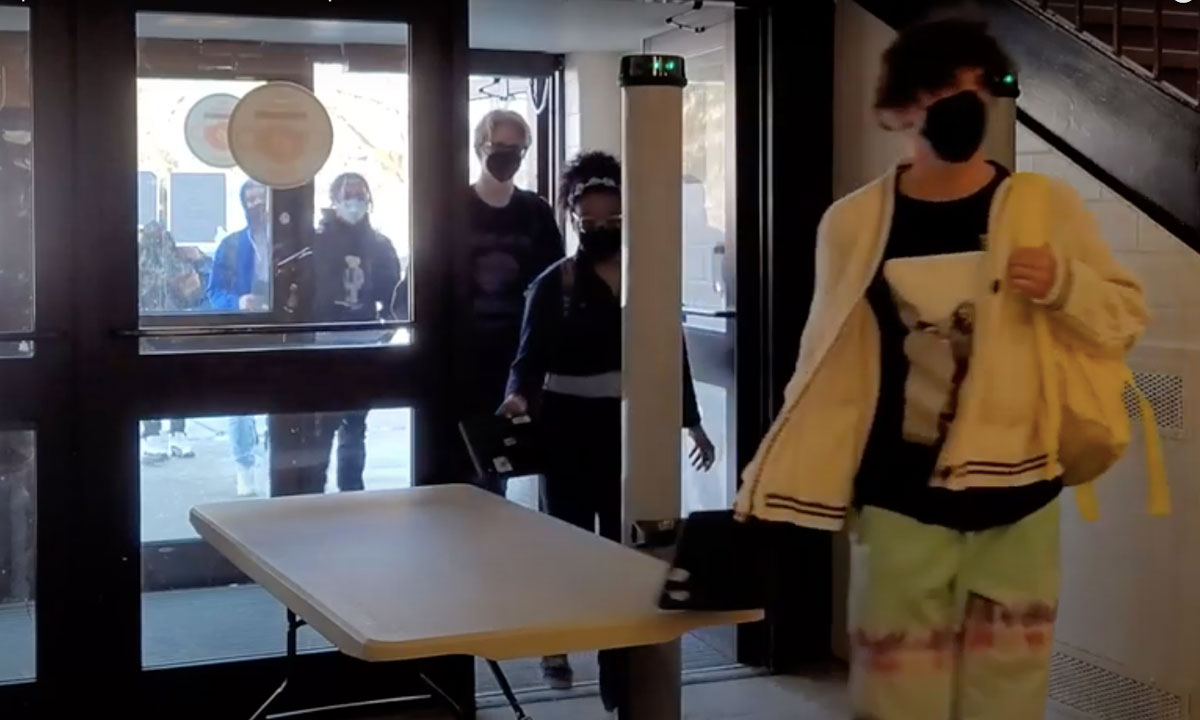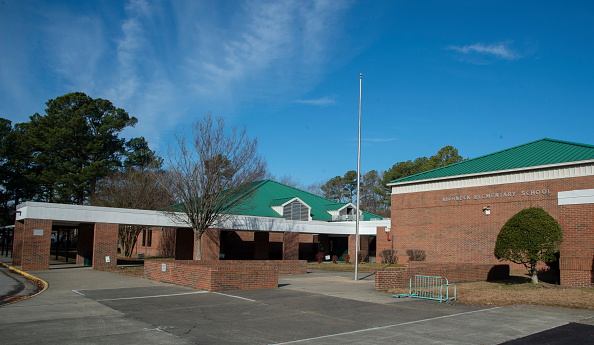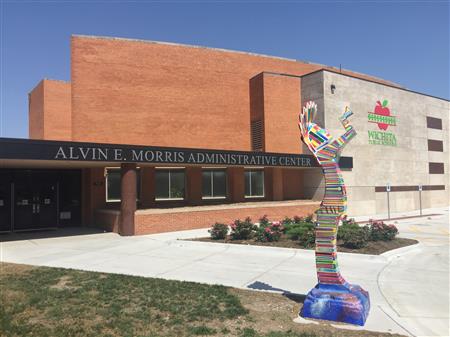The Latest School ‘Weapons Detection’ Tech Can Miss Serious Threats, Experts Say
The next-gen scanners going into Newport News and other districts have significant limitations, like failing to detect knives

Get stories like these delivered straight to your inbox. Sign up for The 74 Newsletter
Students at Newport News’s Richneck Elementary School returned to campus Monday for the first time since their 6-year-old classmate shot his teacher. Much has changed since that horrific Jan. 6 event, including a new high-tech “weapons detection” system the young children now have to pass through — one that promises to ferret out threats in backpacks and pockets without the hassles of airport-style screening checkpoints.
Such a threat was carried into the school nearly four weeks ago and went undetected despite reportedly multiple warnings to school leaders that the first grader was armed. Though school safety experts said that human errors led to a violence prevention breakdown, much of the district’s response hinges on unproven technology that’s being installed on every campus, starting with Richneck.
“Walk-through metal detectors will be in place and used for all students, faculty, staff and visitors to Richneck upon school reopening,” school board Chairman Lisa Surles-Law said earlier this month. “As of yesterday, funding for all 90 state-of-the art metal detectors has been obtained.”
The district spent more than $1.5 million on Opengate scanners, the district spokesperson told The 74. The devices come from Ohio-based metal detector manufacturer CEIA, which says its latest hardware is far smarter than the metal detectors of yesteryear. With “extreme threat item discrimination,” the sensors are designed to distinguish cell phones, water bottles and other innocuous items from “mass casualty shooting weapons” without getting tripped up by false alarms.
The CEIA scanners, and similar devices that have become a trendy segment of the $3.1 billion-a-year school security marketplace, purport to solve roadblocks that have long kept traditional metal detectors from widespread adoption in schools: long checkpoint lines, the need to empty pockets of change and keys, separate X-ray scanners for backpacks and purses, and an appearance that evokes a prison.
Yet as districts nationwide shell out millions of dollars on weapons detectors from CEIA, Evolv Technology and competing vendors, school safety experts warn the devices have significant limitations that can leave serious threats undetected.
Campus security personnel must decide whether to use sensitivity settings that could miss certain weapons in the name of expedience or to be more thorough but get besieged by false alarms from commonplace school supplies like laptops and three-ring binders.
“In some schools, the number of false alarms on these items is staggering,” said Nikita Ermolaev, a research engineer at IPVM, a security industry research group. Due to “a phenomena called alarm fatigue or, in layman’s terms, the boy-who-cried-wolf effect,” he said screening technology that inundates security staff with false alarms can be dangerous.
“By the enormous amount of false alarms on everyday objects that students carry through them in schools, you create a false sense of security because a weapon, such as a knife or a gun, can easily be missed.”
On the day of the Newport News shooting, school employees warned leaders at least three times that the 6-year-old shooter might be armed, according to the wounded teacher’s attorney. Alerts included a shrugged-off request to search his pockets and a teary report from another child that the boy showed him the gun at recess. These human failures were the real security breakdown rather than a lack of hardware, said Jaclyn Schildkraut, interim executive director of the Regional Gun Violence Research Consortium at the Rockefeller Institute of Government.

“The school missed an opportunity to do a threat assessment on this kid, so instead of beefing up their threat assessment policies they’ve now put metal detectors in as if it’s going to somehow undo what happened,” said Schildkraut, who warned the devices could have the opposite of their intended effect, elevating student fears of campus violence. “You’re now telling these students, who have existed in this school without metal detectors, ‘Guess what, your school is not safe.’”
While there’s limited evidence to suggest that scanners are effective at preventing school shootings and other campus violence, the latest “weapons detectors” offer little more than “a fancy, gimmicky name for a metal detector,” Schildkraut said.
“It may be a more sensitive metal detector, but it’s still a metal detector,” she said.
Weapons, undetected
CEIA’s marketing materials say its product is built to detect “high caliber assault weapons and other large mass casualty metal threats,” raising questions about its ability to find handguns — like the one used by the 6-year-old to critically injure his teacher — without overwhelming security staff with false alarms. CEIA didn’t respond to interview requests. The company has acknowledged it does not consider pocket knives to be a “mass casualty threat” and its weapons detection system is not designed to catch anything smaller than “a tactical knife — a knife that’s actually designed for killing.”
“If you want to be able to catch the smaller items” like Swiss Army Knives and vape pens, “I’m going to alarm on a lot more things and I’m back to where I can’t carry a backpack full of stuff” through the detectors, Tom McDermott, CEIA’s school safety and security sales manager, said in a promotional video with Campus Safety magazine. “So there’s always that tradeoff, and that’s a conversation I have with schools all the time.”
When Richneck Elementary students returned on Monday, they were greeted by a police presence and given clear backpacks for their belongings. Richneck now has two security officers, instead of sharing one with another school, a district spokesperson told ABC News. There was also a leadership shakeup. The school principal was reassigned, its vice principal resigned and the district superintendent was fired.
CEIA competitor Evolv has also faced scrutiny for claiming its scanners can catch all types of weapons but in practice may miss large knives and bombs. An Evolv spokesperson said it works with customers to pick a sensitivity setting that best fits their individual needs and is transparent with them about limitations. Providing information about its sensitivity settings with the general public, the spokesperson said in a statement, “is irresponsible and puts people at greater risk.”
“We must assume any published information regarding details of a physical screening system will be studied and leveraged by a bad actor seeking to do harm,” the statement continued. The company declined to comment on the false alarm rates reported by its customer school districts. “Our systems are designed to detect many types of weapons and components of weapons, but there is no perfect solution that will stop 100% of threats, including ours, which is why security must include a layered approach that involves people, process and technology.”
Several security experts said the devices shouldn’t be called weapons detectors if they’re incapable of picking up on certain bladed objects, and Luca Cacioli, CEIA’s CEO, acknowledged to IPVM the term is a “marketing word” and that such devices, which identify metallic objects, are “the same metal detectors that were developed in the ’60s.”
In at least one security incident, the distinction between mass casualty and other weapons proved dangerous.
Last year, the school district in Utica, New York, spent $3.7 million on weapons detectors from Evolv Technology, a publicly traded company backed by big-name investors including Bill Gates and Peyton Manning. The company claims its artificial intelligence-equipped devices can screen up to 1,000 students in 15 minutes — 10 times faster than traditional metal detectors.
The Evolv scanners became the center of controversy in October and were ultimately removed after a student was stabbed multiple times with a knife during a fight in a high school hallway, leaving him with wounds on his back and hands. An investigation revealed the knife-wielding student had passed through an Evolv scanner with the blade in his backpack undetected.
In another incident, the Evolv system failed to alarm when an off-duty police officer accidentally brought a service revolver to a campus open house, the Utica Observer-Dispatch reported. Yet, on another occasion, the system was set off by a student’s lunch box. After the stabbing and before removing the Evolv tech entirely, district officials cranked the scanners to the highest setting, doubling the false alarm rate to roughly 50%. Other districts have reported false alarm rates as high as 32%.
“The Evolv weapons system was designed for use at large arenas or stadiums to prevent incidents of mass casualties and is not adequate or practical for school use,” Brian Nolan, the acting superintendent in Utica, said at a recent school board meeting.
That hasn’t stopped other districts from purchasing its products. Evolv announced a $2.6 million contract with Atlanta Public Schools a few weeks ago.
High failure rates in airports
The use of metal detectors in schools dates back several decades, particularly in large urban districts like New York City. Yet unlike other physical security measures like surveillance cameras, they’ve never received widespread adoption due to inconveniences that next-gen weapons detectors promise to address.
During the 2019-20 school year, just 6% of schools — and fewer than 2% of elementary schools — used metal detectors to conduct random searches on students, according to the most recent federal data. An even smaller share of schools — just 2.7% — required daily metal detector screenings.
While metal detectors offer a visual appearance of security, their ability to keep people safe has faced significant questions. In fact, there’s little evidence to support their use in schools, according to a 2019 research review by the WestEd Justice and Prevention Research Center. In December, a high school student in Akron, Ohio, was caught on campus with a gun that escaped the metal detector altogether when a classmate let him in through a side door.
“When we hear about the introduction of metal detectors in schools where they haven’t previously been, it tends to be reactionary, to something like what happened in Virginia,” said Schildkraut, who co-authored the WestEd report.
In New York City, students of color are far more likely to attend schools with metal detectors, with racial disparities prompting criticism from civil rights advocates. Yet city data indicate less than half of weapons recovered from students were identified with metal detectors.
With heightened school violence fears in his community since the Jan. 6 shooting, Newport News school board member Gary Hunter told The 74, metal detectors are an appropriate approach “if it makes the teachers feel safe.” But he also noted considerable tradeoffs, expressing concern that installing scanners could come at the expense of positive campus climates while sidestepping necessary conversations about American gun laws.
“Ten years from now, in many of our cities, our schools will look like prisons,” Hunter said. “Where does it stop?”
There is some anecdotal evidence of metal detectors, and modern weapons detectors, keeping guns out of schools. Earlier this month in Jamestown, North Carolina, law enforcement officials credited an Evolv scanner for finding a loaded handgun inside a high school student’s backpack. Yet, other districts have reported guns getting through undetected and widespread false flags.
Even in airports, with robust and daunting screening checkpoints, metal detectors have striking limitations, federal data indicate. In 2015, undercover investigators with the Transportation Security Administration were able to smuggle mock explosives and weapons through checkpoints in a startling 95% of efforts. Two years later, the agency found marginal improvements with a 70% failure rate.
“TSA, their only job is to keep weapons off of a plane and they fail at that 80% to 90% of the time,” Schildkraut said. “So now you’re expecting metal detectors in schools where people who are operating them have less training and more responsibility to somehow do a better job.”
Just one tool
As schools nationwide experience a surge in firearm incidents, districts are increasingly turning to weapons detection systems, like the one offered by CEIA. In Wichita, Kansas, for example, district leaders began to roll out the company’s Opengate scanners this year after five guns were found in schools in a three-week period.

Terri Moses, the district’s director of safety and environmental services, said that while the new scanners won’t catch every threat, they’ve become one important tool among many to keep students safe. In fact, she knows the devices have notable shortcomings: An inability to detect certain knives, which she characterized as a “tradeoff” for the convenience that traditional metal detectors don’t offer. Educators must remain diligent about potential campus threats, Moses told The 74.
“We always encourage our teachers, our staff or other students to report anything that is inappropriate and not to take for granted that just because we have this that something can’t get through it, or that somebody isn’t finding another way to get around it,” she said. “It is not a solution, it is another tool in the toolbelt that our district has chosen to use to improve safety.”
For school security consultant Kenneth Trump, president of the Cleveland-based National School Safety and Security Services, the devices’ failure to capture knives is a major red flag since students have long been more likely to bring them to school than guns.
“Some might argue ‘yes, a bladed weapon is a threat but you’re not going to take out 20 people in a matter of minutes or seconds like a gun,’” he said. “That’s true, but if you’re telling me that you’re selling a weapons detection system, I would expect it to detect more than guns.”
Even as CEIA markets its product as having “a near-zero low nuisance alarm rate on personal, non-threat items,” the system and its competitors have proven no match for a common foil in schools: Chromebooks. In Wichita, students are instructed to pass their Chromebooks around the scanner as they walk through, Moses said. In other districts, students have been instructed to hold their laptops above their heads.
At a certain point, Ermolaev of IPVM said that false alarms from Chromebooks and other innocuous items put the weapons detectors from CEIA and Evolv in the same realm as traditional metal detectors, which are much less expensive.
“If you put both systems to the highest sensitivity setting, it will be similar to a metal detector because it will false alarm on pretty much everything,” he said. “Which will inherently bring this screening experience closer to TSA-like screening, which was one of the [things school districts were trying to avoid by purchasing] CEIA or Evolv in the first place.”
Get stories like these delivered straight to your inbox. Sign up for The 74 Newsletter


